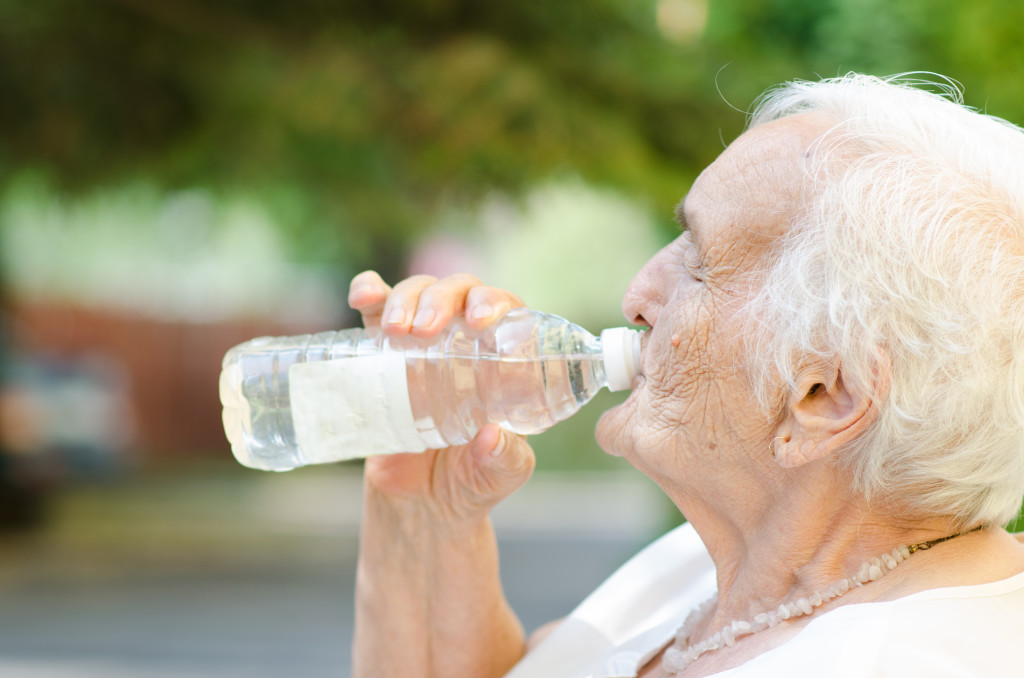As we enter the hot months of summer, much attention will be given to the topic of staying hydrated. Unfortunately, many older adults fail to drink enough fluids and are not aware that many health conditions can increase the risk of dehydration.
Studies show that as many a 1 in 3 older adults may not be getting enough fluid. A person’s total body water decreases with age (from 60 to 52 percent in men, and from 52 to 46 percent in women), and so they have less water to lose before becoming dehydrated. What they don’t realize is that dehydration can be dangerous and even fatal.
Fluid helps to carry oxygen and energy to the body and take away waste products. Without these fluids and electrolytes, the body has difficulty functioning normally. Our bodies cannot store fluid, so it has to be replaced every day. Getting enough fluids can be challenging for older adults who often have a decreased thirst sensation and may not recognize that they are thirsty.

There are many other reasons why dehydration tends to be more common in older adults. In addition to a decreased thirst sensation, kidneys may also function less efficiently. Changes in physical condition that affects walking, reaching for a glass and feeding themselves also make it challenging to get enough fluids. Cognitive decline – confusion and deteriorating memory – can also make it hard to get enough fluids.
The environment, medications and physical activity also play a role. People perspire more in a hot or humid environment or when they walk, weight lift or garden. Sometimes medications, especially diuretics, can result in fluid loss. Diuretics are used to treat heart failure and hypertension, which are common ailments in older adults. Diuretics will cause individuals to go to the bathroom with greater frequency. The use of laxatives will also cause the loss of fluids.
As people age, it’s not uncommon to have weakened pelvic muscles that create a fear of having ‘accidents’, especially at night. Helping older adults feel comfortable will make drinking enough fluids a less stressful and potentially embarrassing process. Ensuring that the bulk of liquids are consumed earlier in the day, emphasizing the importance of using the bathroom before bed, and using incontinence-friendly undergarments are all ways to safeguard against accidents and help prevent dehydration.
Knowing the signs and symptoms of dehydration can aid older adults in getting the fluids they need. Weight loss, increased heart rate and low blood pressure are three symptoms of dehydration. Decreased skin firmness is another. The skin of a dehydrated person lacks its normal elasticity and sags back into position slowly when pinched up into a fold. Normally, the skin springs back into position.
Other signs are dry mouth and tongue, decreased urination, constipation or fecal impaction, nausea, anorexia, sunken eyeballs and decreased functional ability. In some cases, dehydration can cause weakness, trembling, lethargy or confusion.
The amount of fluid a person needs depends on their body size and health conditions. A registered dietician can help determine the optimum fluid requirement.
Milk, juice, coffee, tea and water all count as fluids. Keep in mind that caffeinated coffee and tea act like diuretics and increase the need to go to the bathroom. Milk provides protein, calcium and vitamin D. Juice does not have the same nutritional value as whole fruit, but can add significant calories that may not be needed.
Individuals who eat well can also get the equivalent of two to three 8-ounce glasses of water from the fluids found in the foods they eat. Fruits and vegetables have high water content. So do soups, gelatin and pudding. Dry foods such as snack foods, cookies and cheeses have low water content. If a person is not eating well, they may need additional fluids to make up for the fluids they are not consuming.
Caregivers and family members can help older adults by making sure that fluids are received at every meal and at set times between them. Establishing this routine will ensure that an individual isn’t relying on thirst to indicate that they need fluids.
Some things to try at home include:
- Having a beverage with each meal and snack
- Keeping fluids handy – a pitcher of water with lemon slice in the refrigerator can be very appealing
- Enjoying a beverage when watching TV or reading
- Drinking more water than necessary to swallow medications
- Pouring a half-gallon of water in a pitcher every morning. Use it for any beverage needs throughout the day until empty
- Eating the recommended 5 to 9 servings of fruits and vegetables each day for essential nutrients and fluids
- Making a healthy soup meal – with low sodium
- Taking a bottle of water on outings
For more information about how Lifeline Homecare can help care for you or a loved one, and for a free in-home assessment, call us 1-844-LIFELINE (1-844-543-3545) or email care@lifelinehomecare.org.

